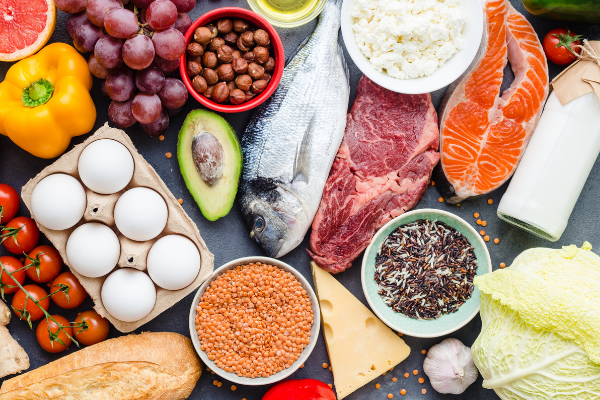Issued by the Minister of Health, Decision 1294/QD-BYT in 2022 on Action Plan to implement the National Strategy on nutrition by 2025. Accordingly, the proportion of overweight is increasing rapidly in all age groups in Vietnam.
Nutritional status in Vietnam in recent years?
Pursuant to subsection 1, Section I of the Action Plan issued with Decision 1294/QD-BYT in 2022, clearly stating the nutritional status of Vietnam, in which there are some notable things as follows:
- The situation of stunting malnutrition among children under 5 years of age is decreasing gradually, from 2010 to 2020, the national rate of stunting malnutrition will decrease from 29.3% to 19.6%, turning from high to high. average level according to the World Health Organization classification of public health problems and on track to meet the Global Nutrition Goal 2025 on reducing stunting malnutrition.
- The prevalence of overweight/obesity (closely related to diet and lifestyle) is increasing rapidly in all age groups both in urban and rural areas. Overweight/obesity among children under 5 years old is 7.4% (9.8% in urban areas; 5.3% in rural areas) and very high at 19% for school-age children, compared with the rate respectively in 2010 are 5.6% and 8.5%.
- Vitamin A deficiency, anemia, iron deficiency and zinc deficiency are still significant public health issues. Currently, the rate of Vitamin A deficiency and anemia in women of childbearing age and children under 5 years old has improved, but the results have not yet reached the set target. According to a survey by the Institute of Nutrition, by 2020, the rate of anemia in children under 5 years old in Vietnam is 19.6%. The prevalence of anemia in pregnant and non-pregnant women is 25.6% and 16.2%, respectively. Pre-clinical vitamin A deficiency in children under 5 years old is 9.5%. The percentage of vitamin A in breast milk is as low as 18.3%. The rate of zinc deficiency is especially high in children under 5 years old at 58% in 2020; pregnant women is 63.5%, ranked at the severe level of public health significance.
- In general, people's diets have had positive improvements in average energy in the diet reaching 2023 Kcal/day, a slight increase compared to the energy level of 1925 Kcal/day in 2010. Energy structure from Protein, Lipid and Glucid are 15.8%: 20.2%: 64.0% (compared to total energy intake), this structure is considered balanced according to recommendations for Vietnamese people. People's fruit and vegetable consumption has increased per capita from 190.4 grams of vegetables/person/day; 60.9 grams of ripe fruit/person/day (in 2010) to 231 grams of vegetables/person/day; 140.7 grams of ripe fruit/person/day (in 2020); However, the consumption of vegetables and fruits among adults is only about 66.4-77.4% of the recommended demand of Vietnam. Meanwhile, meat consumption increased rapidly from 84.0 grams/person/day (2010) to 136.4 grams/person/day (2020); In urban areas, consumption is higher at 155.3 grams/person/day. Rice consumption tends to decrease. Students in the city tend to increase their consumption of soft drinks and industrially processed foods.
.png)
The rate of excess need is increasing rapidly among all age groups in Vietnam
Results of the implementation of the National Strategy on Nutrition for the period 2011-2020?
Pursuant to subsection 2, Section I of the Action Plan issued together with Decision 1294/QD-BYT in 2022, the implementation results are as follows:
- Assessing the objectives of the Strategy, Vietnam has basically achieved the goals of reducing undernutrition in mothers and children (reducing the rate of underweight malnutrition, stunting malnutrition, The prevalence of chronic energy deficiency in women of childbearing age, basically controlling the rate of overweight and obesity in children under 5 years of age, improving the average height of children and the achieved height of young people, improving improving performance indicators on infant feeding). There are differences between the targets achieved by region, however, in the past period, no specific target has been set specifically for mountainous areas and ethnic minority areas where the percentage of people living in poverty is high. Malnutrition remains high. In addition, Vietnam has not yet achieved the targets related to improving micronutrient deficiencies, controlling overweight and obesity in adults and a number of indicators related to improving the capacity to implement the Strategy. comb.
- Difficulties and shortcomings in the implementation of the National Strategy on Nutrition for the period 2011-2020 include:
+ Party committees and authorities in many localities are not fully aware of the importance of nutrition for health and socio-economic development, especially maternal and child nutrition. Therefore, they have not paid attention to investing in nutrition work, not considering this as a priority political task in the socio-economic development of the locality. Many localities have not yet included the target of reducing stunting in their annual socio-economic development plans. The issue of household food security and nutrition security has not been specifically mentioned in development policies and plans, and there are no goals, solutions and resource allocation.
+ Financial resources for nutrition work in general, especially in mountainous areas and ethnic minority areas, have not yet met the requirements. The central budget for the nutrition program has been reduced, the local budget has not increased or increased disproportionately due to lack of resources and obstacles in terms of financial guidance and mechanisms for nutrition activities.
+ There is still a lot of interdisciplinary cooperation in nutrition activities
Inadequacies, not integrating and effectively deploying investment resources of departments, agencies and mass organizations, especially in the locality. Nutrition is considered a health issue, so activities are mainly undertaken by the health sector, lacking structure and inter-sectoral coordination.
+ About nutrition policy: The provisions of the law on nutrition are not really synchronized and updated. Policies and action plans do not come with budget commitments. Lack of reporting, monitoring and evaluation mechanism as well as lack of policies to ensure healthy food production and consumption; Restricting unhealthy foods especially to children through nutrition labeling, taxation and advertising restrictions. Lack of specific nutrition policies for some vulnerable groups (due to physiological, pathological, occupational and emergency situations due to natural disasters and epidemics). + Many important nutritional interventions are decisive to the growth of children's stature and physical strength such as nutritional care for the first 1000 days of life, nutrition for pregnant and lactating mothers, prevention of stunting, malnutrition, and stunting. Prevention and control of micronutrient deficiencies, nutritious meals in households, schools, specific occupations and toxic environments, are only deployed on a narrow scale, not reaching the majority of target groups. target audience and the general population.
+ People in both rural and urban areas still lack understanding about proper nutrition. Communication on nutrition has not been effective in mountainous areas and ethnic minority areas due to limitations in approach, differences in language, cultural level, and customs.
+ In addition, in Vietnam as well as in other countries in the region have been affected by the process of globalization, rapid urbanization, changing food environment, adverse impacts of climate change. post-population aging.
Khanh Linh
 Article table of contents
Article table of contents

.png)
.png)






